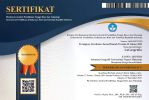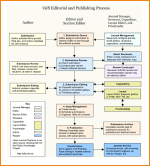Pemetaan Tingkat Rawan Bencana Banjir di Daerah Aliran Sungai Maros Provinsi Sulawesi Selatan
(1) Universitas Negeri Makassar
(2) Universitas Negeri Makassar
(3) Universitas Negeri Makassar
(*) Corresponding Author
DOI: https://doi.org/10.35580/lageografia.v18i3.13930
Abstract
Keywords
Full Text:
PDFReferences
Agus, M. (2005). Banjir, Kekeringan dan Lingkungan. Universitas Gajah Mada.
Arfan, A., Maru, R., & Side, S. (2020). Persepsi Masyarakat dalam Pengelolaan Kawasan Hutan Mangrove sebagai Wilayah Produksi di Kabupaten Luwu. LaGeografia, 18(2), 150–159.
Arsyad, S. (2010). Soil and Water Conservation (Konservasi Tanah dan Air) 2 (Bogor. IPB Press.
Asdak, C. (2018). Hidrologi dan pengelolaan daerah aliran sungai. Gadjah Mada University Press.
Fitri, A., Invanni, I., & Arfan, A. (2020). Tingkat Kebutuhan Ruang Terbuka Hijau. LaGeografia, 18(2), 90–98.
Hadisusanto, N. (2011). Aplikasi hidrologi. Yogyakarta: Jogja Media Utama.
Loebis, J. (1992). Banjir Rencana Untuk Bangunan Air. Departemen Pekerjaan Umum.
Luthfi, L. (2010a). Banjir dan Faktor Penyebabnya. Http://Kampustekniksipil.Blogspot.Com/.
Luthfi, L. (2010b). Penanganan Masalah Banjir. Http://Kampustekniksipil.Blogspot.Com/.
Notohadiprawiro, T., & Suparnowo, S. H. (1978). Asas-Asas Pedologi. Departemen Ilmu Tanah Fakultas Pertanian Universitas Gadjah Mada, Yogyakarta.
Purnama, A. (2008). Pemetaan Kawasan Rawan Banjir di Daerah Aliran Sungai Cisadane Menggunakan Sistem Informasi Geografis. Skripsi. Fakultas Kehutanan. Institut Pertanian Bogor.
Saputro, A., Nyompa, S., & Arfan, A. (2019). Analisis Pemanfaatan Hutan Mangrove dan Kontribusinya Terhadap Pendapatan Rumah Tangga Masyarakat di Pulau Tanakeke Kabupaten Takalar. LaGeografia, 18(1), 70–81.
Seyhan, E. (1995). Dasar-dasar hidrologi, Indonesian edition. Gadjah Mada University Press, Yogyakarta.
Sutikno. (1995). Geomorfologi Konsep dan Terapannya. Gadjah Mada.
Wilson, E. M. (1993). Hidrologi Teknik. Institut Teknologi Bandung. Bandung.
Article Metrics
Abstract view : 1009 times | PDF view : 445 timesRefbacks
Copyright (c) 2020 Nasiah Badwi, Ichsan Invanni, Ibrahim Abbas

This work is licensed under a Creative Commons Attribution-NonCommercial 4.0 International License.
LaGeografia: Jurnal Program Studi Pendidikan Geografi, Jurusan Geografi, Fakultas MIPA, Universitas Negeri Makassar.
Email: [email protected] | +6285298749260
Editorial Office













































